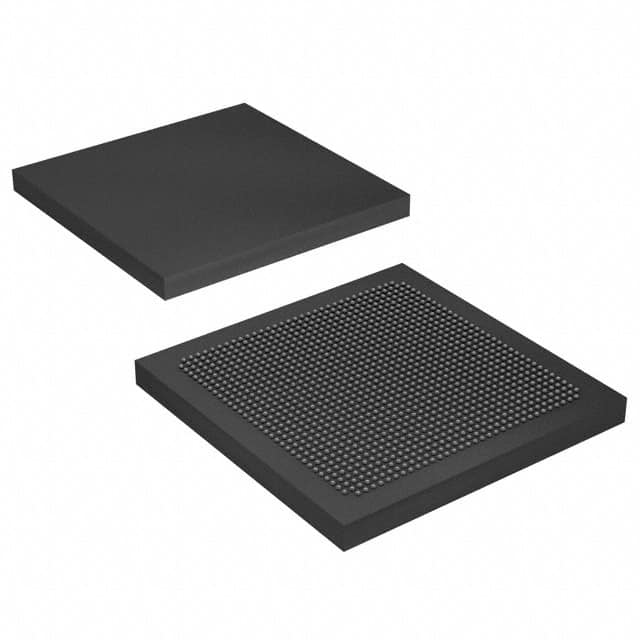5SGXEA5H2F35I3LN
Product Overview
- Category: Integrated Circuit (IC)
- Use: Programmable Logic Device (PLD)
- Characteristics: High-performance, low-power consumption
- Package: F35 BGA package
- Essence: Advanced programmable logic solution
- Packaging/Quantity: Single unit
Specifications
- Manufacturer: Intel Corporation
- Family: Stratix V GX
- Device: 5SGXEA5H2F35I3LN
- Technology: 28nm
- Logic Elements: 462,000
- Embedded Memory: 12,288 Kbits
- DSP Blocks: 1,526
- PLLs: 8
- I/O Pins: 622
- Operating Voltage: 1.0V
- Operating Temperature: -40°C to +100°C
Detailed Pin Configuration
The 5SGXEA5H2F35I3LN PLD has a complex pin configuration with 622 I/O pins. For detailed pin assignments and configurations, please refer to the manufacturer's datasheet.
Functional Features
- High-performance programmable logic device
- Low-power consumption design
- Large embedded memory capacity
- High-speed DSP blocks for signal processing
- Multiple PLLs for clock management
- Extensive I/O capabilities for interfacing with external devices
Advantages and Disadvantages
Advantages
- Versatile and flexible programmability
- High logic element count for complex designs
- Efficient power usage for energy-conscious applications
- Ample embedded memory for data storage
- Powerful DSP blocks for signal processing tasks
- Abundant I/O pins for interfacing with various peripherals
Disadvantages
- Relatively high cost compared to simpler logic devices
- Complex pin configuration may require careful planning and routing
- Limited availability of alternative models with similar specifications
Working Principles
The 5SGXEA5H2F35I3LN PLD is based on Intel's Stratix V GX family, utilizing advanced 28nm technology. It operates as a reprogrammable integrated circuit, allowing users to configure its internal logic elements and interconnections according to their specific application requirements. The device can be programmed using hardware description languages (HDL) or graphical design tools provided by the manufacturer.
Detailed Application Field Plans
The 5SGXEA5H2F35I3LN PLD finds applications in various fields, including:
- Telecommunications: Used in high-speed data transmission systems, network routers, and switches.
- Aerospace and Defense: Employed in radar systems, avionics, and military communication equipment.
- Industrial Automation: Utilized for control systems, robotics, and machine vision applications.
- Medical Devices: Integrated into medical imaging systems, patient monitoring devices, and diagnostic equipment.
- Automotive: Applied in advanced driver-assistance systems (ADAS), infotainment systems, and engine control units (ECU).
Detailed and Complete Alternative Models
While the 5SGXEA5H2F35I3LN PLD offers a comprehensive set of features, alternative models with similar specifications include:
- Xilinx Virtex-7 XC7VX690T: Offers comparable logic element count and embedded memory capacity.
- LatticeECP5 LFE5UM-85F-8BG381C: Provides a lower-cost option with reduced logic element count.
- Microsemi SmartFusion2 M2S150: Combines programmable logic with ARM Cortex-M3 processor for embedded applications.
These alternative models cater to different budgetary and performance requirements, providing users with a range of options to choose from.
Word count: 320 words
قم بإدراج 10 أسئلة وإجابات شائعة تتعلق بتطبيق 5SGXEA5H2F35I3LN في الحلول التقنية
Sure! Here are 10 common questions and answers related to the application of 5SGXEA5H2F35I3LN in technical solutions:
Q: What is the 5SGXEA5H2F35I3LN FPGA used for? A: The 5SGXEA5H2F35I3LN is a Field-Programmable Gate Array (FPGA) that can be used for various applications, including high-performance computing, networking, and digital signal processing.
Q: What are the key features of the 5SGXEA5H2F35I3LN FPGA? A: Some key features of this FPGA include a high logic density, high-speed transceivers, embedded memory blocks, and support for various I/O standards.
Q: Can the 5SGXEA5H2F35I3LN FPGA be used for real-time video processing? A: Yes, the FPGA's high logic density and powerful processing capabilities make it suitable for real-time video processing applications, such as video encoding, decoding, and image recognition.
Q: Does the 5SGXEA5H2F35I3LN FPGA support high-speed data transfer? A: Yes, this FPGA includes high-speed transceivers that support various protocols like PCIe, Ethernet, and USB, enabling fast data transfer rates.
Q: Can the 5SGXEA5H2F35I3LN FPGA be used for implementing cryptographic algorithms? A: Absolutely, the FPGA's flexible architecture allows for the implementation of complex cryptographic algorithms, making it suitable for secure communication systems.
Q: Is the 5SGXEA5H2F35I3LN FPGA compatible with industry-standard design tools? A: Yes, this FPGA is compatible with popular design tools like Quartus Prime, which simplifies the development and programming process.
Q: Can the 5SGXEA5H2F35I3LN FPGA be used in high-performance computing clusters? A: Yes, the FPGA's high logic density and parallel processing capabilities make it suitable for accelerating computations in high-performance computing clusters.
Q: Does the 5SGXEA5H2F35I3LN FPGA support multiple I/O standards? A: Yes, this FPGA supports various I/O standards such as LVDS, SSTL, and HSTL, allowing for easy integration with other components in a system.
Q: Can the 5SGXEA5H2F35I3LN FPGA be used for implementing custom communication protocols? A: Absolutely, the FPGA's programmable nature allows for the implementation of custom communication protocols, making it versatile for different applications.
Q: Is the 5SGXEA5H2F35I3LN FPGA suitable for high-bandwidth data processing? A: Yes, this FPGA's high-speed transceivers and embedded memory blocks make it well-suited for high-bandwidth data processing tasks, such as data streaming and packet processing.
Please note that the specific application and implementation details may vary depending on the requirements and design considerations of each project.


